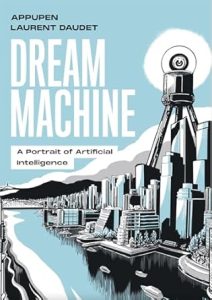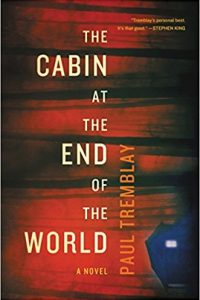Dream Machine: A Portrait of Artificial Intelligence by Appupen & Laurent Daudet: Review by Archita Mittra
 Dream Machine: A Portrait of Artificial Intelligence, Appupen & Laurent Daudet (The MIT Press 978-0-26255-129-8, $29.95, 160pp, tp) August 2024.
Dream Machine: A Portrait of Artificial Intelligence, Appupen & Laurent Daudet (The MIT Press 978-0-26255-129-8, $29.95, 160pp, tp) August 2024.
The graphic novel Dream Machine is the brainchild of versatile Indian artist Appupen (known for Legends of Halahala, The Snake and the Lotus, and other inventive myth-building comics) and Laurent Daudet, a French physicist and AI researcher. Educational and engaging, the book delves into the wide-reaching ramifications of AI technology by narrating the fictional story of Hugo, the founder of a start-up specializing in Large Language Models (LLMs) who receives a lucrative proposal to work for one of the biggest megacorporations in the world – an opportunity fraught with ethical dilemmas and shady scheming. Thus, Dream Machine carefully and cleverly highlights the many pitfalls of the ChatGPT revolution in our modern-day capitalist economies while also breaking down key concepts relating to generative AI to those unfamiliar with such technologies.
The frame narrative in Dream Machine follows Hugo, a Parisian entrepreneur and founder of KLAI, a small tech start-up whose language translation AI model has captured the notice of REAL.E, a megacorporation clearly inspired by companies such as Meta and X Corp. REAL.E claims to be working on an ‘‘immortality game’’ combining the features of social media platforms and the tactics of survival horror games – easily a facade for crowd surveillance and data theft. As Hugo contemplates whether or not he should sell out his company for personal gain, he is confronted with questions of inequality and injustice. For the most part, Dream Machine takes a pedagogical approach, explaining in bite-sized speech bubbles how LLMs work (‘‘huge computer programs that run statistics’’), the many prompting techniques to fine-tune AI programs, their potential applications in various fields from medicinal research to automating labor and beyond. But more importantly, the graphic novel makes it a point to voice the urgent ethical concerns at the heart of all AI conversations happening today, particularly the insuperable energy costs required to run such programs and the unequal toll it will most definitely take on the residents of the Global South who are already unfairly affected by climate change.
As its subtitle ‘‘A Portrait of Artificial Intelligence’’ indicates, Dream Machine could easily function as an introductory textbook on AI, but Appupen’s signature art style – evocative, layered, and filled with veiled references to his other works – elevates the book into a powerful critique of consumer capitalism and the wish-fulfilling fantasies of technocrats. This is most evident in the ‘‘SuperHugo’’ episodes – a mini comic-within-a-comic wherein Hugo’s unconscious fears and fantasies are literalized in a dystopian dreamscape that could very well become humanity’s future if the concerns surrounding AI remain unheeded. With its simple and instructional narration, the supporting characters thus appear rather one-dimensional, serving a didactic function within the text, be it the cartoonist Ayyo (perhaps a stand-in for Appupen himself) and Hugo’s partner, Anna – both acting as foils to our protagonist’s dubious conscience. These characters also provide an opportunity for the collaborators to make a few points adjacent to AI discourse, such as how an overreliance on technology and virtual assistants distances oneself from their loved ones (Hugo ignoring the incessant reminders about his anniversary celebrations with Anna) and the rise of the right-wing government in India, bolstered by feeding the masses with fake news and propaganda. Coupled with the threat of mass layoffs and massive energy costs, Dream Machine offers compelling arguments as to why developments in AI technologies need to be strictly regulated and even stopped.
However, although the book emphasizes at several points on the dangers of AI, its conclusion pointing to a world where AI can be deployed ethically appears to me to be idealistic. It is a fair argument that tech conglomerates should not wield such enormous control over the planet’s resources, but given that generative AI is built on the stolen labor of creative personnel and its very functioning is presently pushing the planet to the brink of destruction (whose consequences again will be borne disproportionately by populations residing in the Global South), I’m personally skeptical of any scenario where AI can serve the greater good or be used in an ethical manner, particularly in the wake of disaster capitalism. In fact, at the time of writing this review, Google and Amazon have both signed deals to use nuclear energy to power their AI data centers – a dangerous move that once again highlights the unfettered power of tech companies and the need for stringent government policies and sanctions to curb their influence before it is too late.
In this regard, the final chapter of this book made me feel a tad uneasy. The collaborators eschew a closed ending and instead offer five different futures, ranging from the utopian to the dystopian, based on whatever decision Hugo may ultimately make. Instead of a straightforward narrative, the final chapter of Dream Machine morphs into a choose-your-own-adventure game, outlining different scenarios created with the aid of ChatGPT and StableDiffusion. Although the art and text were prompted and crafted with the consent of the collaborators, perhaps hinting at our interpolation within AI ecosystems irrespective of whether we like it or not, this creative choice did not sit well with me – surely a critique of generative AI can be achieved without resorting to the use of generative AI?
Perhaps I simply missed the point, or maybe what the collaborators intended was precisely this – a discomfort that forces oneself to reckon with their ethics and morals and engage in further debate and discussion with others. In this light, Dream Machine successfully fulfills its educational task by using a mixture of a contemplative barebones storyline and evocative art to explain various AI terminologies and ask timely questions regarding the same of its readers. It’s a good example of the versatility and beauty of the comics medium to combine storytelling with pedagogy without coming across as didactic. Overall, Dream Machine is suited for readers looking for an introduction the inner workings of AI technology while also contemplating the future of technology unfolding within our present-day capitalist power structures.
Interested in this title? Your purchase through the links below brings us a small amount of affiliate income and helps us keep doing all the reviews you love to read!
Archita Mittra is a writer and artist, with a fondness for dark and fantastical things She completed her B.A (2018) and M.A (2020) in English Literature from Jadavpur University and a Diploma in Multimedia and Animation from St. Xavier’s College.
When she isn’t writing speculative fiction or drawing fanart, she can be found playing indie games, making jewelry out of recycled material, reading a dark fantasy novel, baking cakes, or deciding which new Tarot deck to buy.
She lives in Kolkata, India, with her family and rabbits.
This review and more like it in the December 2024 issue of Locus.
 While you are here, please take a moment to support Locus with a one-time or recurring donation. We rely on reader donations to keep the magazine and site going, and would like to keep the site paywall free, but WE NEED YOUR FINANCIAL SUPPORT to continue quality coverage of the science fiction and fantasy field.
While you are here, please take a moment to support Locus with a one-time or recurring donation. We rely on reader donations to keep the magazine and site going, and would like to keep the site paywall free, but WE NEED YOUR FINANCIAL SUPPORT to continue quality coverage of the science fiction and fantasy field.
©Locus Magazine. Copyrighted material may not be republished without permission of LSFF.










Funny thing: in Bulgarian The Picture of Dorian Gray is translated in what can be interpreted also as The Portrait of Dorian Gray, so my first impulse was to look for parallels with the immortality and the eternal youth angle of the Wilde’s novel… Sound like a missed opportunity.